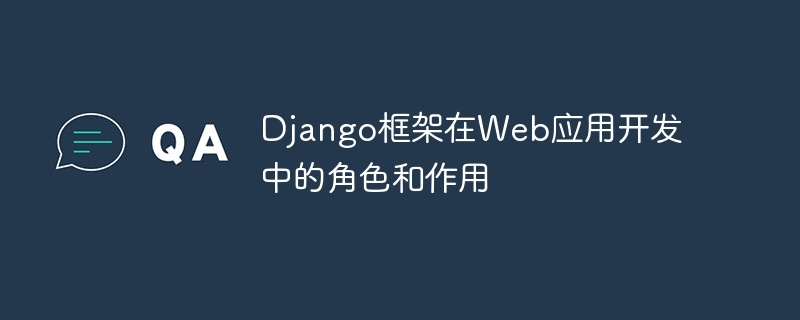Home >Backend Development >Python Tutorial >The role and function of the Django framework in web application development
The role and function of the Django framework in web application development
- PHPzOriginal
- 2024-01-19 08:33:05893browse

The role and function of the Django framework in Web application development requires specific code examples
Django is a framework based on MTV (Model-Template-View) as the architectural pattern Web application development framework, which is mainly used to build high-performance and powerful Web applications. Django is written based on the Python programming language, and its original development intention is to quickly develop web applications.
Django’s main functions include ORM, templates, routing, Session, database management, security management, etc. These full-featured features make Django one of the preferred frameworks for web application development.
The following is a detailed introduction to the role and role of the Django framework in web application development.
- ORM
Django’s ORM (Object-Relational Mapping) is a process of dealing with the database encapsulated in the Python language. It can help us transform database operations into For the operation of Python objects, programmers can directly use Python's object-oriented thinking to manage databases.
Using Django ORM we can define the data model and let ORM create tables and include defined fields. Through ORM, we can perform operations such as adding, deleting, updating, and querying data. Django encapsulates these operations and is very convenient to use.
The following is a simple Django ORM usage sample code:
from django.db import models
class Book(models.Model):
title = models.CharField(max_length=50)
author = models.CharField(max_length=50)
publish_date = models.DateTimeField('date published')
The above code defines a Book model, which contains three attributes, namely title, author, and publish_date.
Django will automatically create corresponding database tables and fields based on the model definition. Using this model, we can easily complete database operations such as adding, deleting, checking, and modifying the Book model.
- Template
Django’s template system allows us to easily separate the structure of the page from the content that needs to be displayed on the page. The template system allows developers to render variables and logical expressions in templates through Django's template engine.
The use of templates allows front-end engineers and back-end engineers to be separated. The front-end focuses on the design and beautification of pages and the implementation of interactive logic, while the back-end developers can focus more on the implementation of business logic, thereby improving Development efficiency.
The following is a simple example of using Django template:
<!DOCTYPE html>
<html>
<head>
<meta charset="UTF-8">
<title>{{ title }}</title>
</head>
<body>
<h1>{{ heading }}</h1>
<ul>
{% for item in items %}
<li>{{ item }}</li>
{% endfor %}
</ul>
</body>
</html>The above code is a simple HTML template example, which contains variables, loops and other logic. We can use Django's template engine to This template is rendered.
- Routing
Django’s routing system allows us to define url routes and assign different requests to corresponding views for processing. Through the routing system, we can manage URL addresses very conveniently, thereby making the entire Web application architecture more optimized.
The following is a simple Django routing example code:
from django.urls import path
from . import views
urlpatterns = [
path('', views.index, name='index'),
path('about/', views.about, name='about'),
path('contact/', views.contact, name='contact'),
]The routing defines three paths, corresponding to the URL addresses of the three requests, index, about, and contact, and their corresponding views. function, when sending a specified URL request, Django will automatically find the matching view function for processing.
- Session
Django’s Session system can help us implement user authentication, remember user status and other functions. Django stores the user's login status in the Session, and the status can be shared between users through the Session.
The following is a simple Django Session sample code:
def login(request):
if request.method == 'POST':
# get user credentials from the request.POST dict
username = request.POST['username']
password = request.POST['password']
# try to authenticate user, and if successful:
user = authenticate(request, username=username, password=password)
if user is not None:
login(request, user)
return HttpResponseRedirect(reverse('index'))
else:
# authentication failed, return an error message
message = "Invalid username/password combination."
return render(request, 'login.html', {'message': message})
else:
return render(request, 'login.html')In the above code, we use Django's Session system for user authentication. When the user successfully logs in, we use Django's login method to store the user state in the Session.
To sum up, the Django framework plays an important role in Web application development. Its ORM, template, routing, Session and other functions can help us easily implement various functions of Web applications.
The above is the detailed content of The role and function of the Django framework in web application development. For more information, please follow other related articles on the PHP Chinese website!

